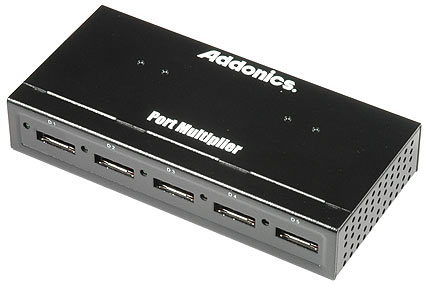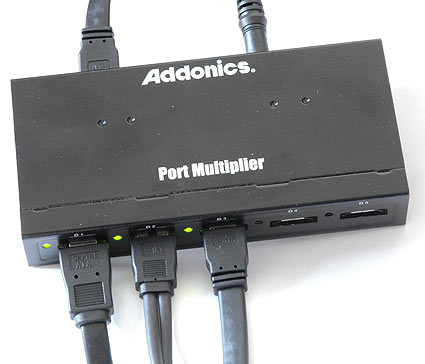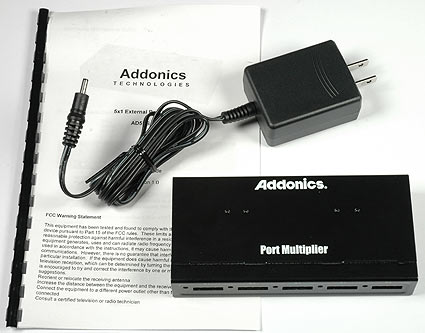Storage Accessories: Move, Cool, Multiply
5-in-1 ESATA: Addonics ESATA Port Multiplier (AD5ESAPM-E)

eSATA (external Serial ATA) has been around for a few years, and although the protocol doesn't differ from SATA used inside the PC, there are a few differences. First of all, the transmission voltages were adjusted from 400-600 mV to 500-600 mV for the sender and from 240-600 to 325-600 mV for the receiver. This was necessary to support external operations and cable lengths of up to 2 m. At the same time, cables and connectors for eSATA are shielded and were designed to be more robust. But eSATA still has one major disadvantage when compared to Ethernet or Firewire: it only supports one drive per port.
Since users don't always want to install more eSATA ports to attach more external drives to a PC and there isn't even the option to add many eSATA ports to notebooks or laptops, Addonics may have a solution. The eSATA Port Multiplier requires an eSATA port with a controller that is AHCI compliant (Advanced Host Controller Interface). This requirement disqualifies all integrated controllers that are two or three years old (ICH7 and older) as well as our reference storage controller, the Promise FastTrak TX4310. However, current chipsets and controllers from AMD/ATI, Intel and Nvidia work well, so we used a Gigabyte X38-DQ6, which has a JMicron JMB373 controller for eSATA.
The real issue is port multiplier compatibility, which AHCI supports. It is first necessary to make sure AHCI is enabled in your motherboard or controller BIOS, because most controllers still support legacy modes. Once we set the JMicron controller to AHCI, we could get started with the Addonics eSATA Port Multiplier.
The device works as simple as the product name sounds: It utilizes one physical Serial ATA connection to run as many as five drives through it. The operation is entirely transparent to the operating system. While 300 MB/s Serial ATA speeds have not really been necessary for single hard drives (the highest transfer rate off the physical discs have been 120 MB/s), it does make a lot of sense if you want to run two or more SATA drives through one physical connection.
If you seek maximum performance at any time, we recommend looking at the throughput of your eSATA drives first and making sure the total bandwidth requirements do not exceed 300 MB/s. Typically, two to three external eSATA hard drives can be operated without running into bottlenecks. Should you use a Silicon Image SIL3124 or 3132 for eSATA, then you also have the option of creating RAID arrays using the Addonics Port Multiplier, as all drives attached to the Addonics eSATA Port Multiplier can be integrated into RAID arrays.
Although the total throughput was lower with the Addonics device compared to the throughput of our test hard drive, a Western Digital Raptor with an internal SATA controller, the overall performance was exactly the same. The device is not bus powered, as a SATA connection does not provide sufficient power to operate the Port Multiplier's core logic. We found the Addonics eSATA Port Multiplier in retail channels for $99, which is quite a lot of money considering that you can get an external 500 GB hard drive for less than $130.





Get Tom's Hardware's best news and in-depth reviews, straight to your inbox.
Current page: 5-in-1 ESATA: Addonics ESATA Port Multiplier (AD5ESAPM-E)
Prev Page New Accessories To Ease The Storage Pain Next Page Permanent And Portable Storage: Silverstone Silverstone MS05